
Pegasus is an air-launched launch vehicle developed by Orbital Sciences Corporation (OSC) and now built and launched by Northrop Grumman. Pegasus is the world's first privately developed orbital launch vehicle. Capable of carrying small payloads of up to 443 kg (977 lb) into low Earth orbit, Pegasus first flew in 1990 and remains active as of 2021. The vehicle consists of three solid propellant stages and an optional monopropellant fourth stage. Pegasus is released from its carrier aircraft at approximately 12,000 m (39,000 ft), and its first stage has a wing and a tail to provide lift and altitude control while in the atmosphere. Notably, the first stage does not have a thrust vector control (TVC) system.
Orbital Sciences Corporation was an American company specializing in the design, manufacture, and launch of small- and medium- class space and launch vehicle systems for commercial, military and other government customers. In 2014, Orbital merged with Alliant Techsystems to create a new company called Orbital ATK, Inc., which in turn was purchased by Northrop Grumman in 2018. The remnants of the former Orbital Sciences Corporation became a subsidiary of Northrop Grumman, known as Northrop Grumman Space Systems.
The STAR-2 Bus is a fully redundant, flight-proven, spacecraft bus designed for geosynchronous missions.

Cygnus is an expendable American cargo spacecraft developed by Orbital Sciences Corporation but manufactured and launched by Northrop Grumman Space Systems as part of NASA's Commercial Resupply Services (CRS) program. It is usually launched by Northrop Grumman's Antares rocket, although three flights were on ULA's Atlas V and three are planned for SpaceX's Falcon 9. It transports supplies to the International Space Station (ISS) following the retirement of the American Space Shuttle. Since August 2000, ISS resupply missions have been regularly flown by the Russian Progress spacecraft, as well as by the European Automated Transfer Vehicle, and the Japanese H-II Transfer Vehicle. With the Cygnus spacecraft and the SpaceX Dragon, NASA seeks to increase its partnerships with domestic commercial aviation and aeronautics industry.
The Mission Extension Vehicle (MEV) is a spacecraft that extends the functional lifetime of another spacecraft through on-orbit satellite servicing. They are 2010s-design small-scale in-space satellite-refueling spacecraft first launched in 2019. The MEV spacecraft grew out of a concept proposed in 2011 by ViviSat, a 50/50 joint venture of aerospace firms US Space and Alliant Techsystems (ATK). The joint venture was created in 2010 for the purpose of designing, producing and operating the MEV program.

A space tug is a type of spacecraft used to transfer spaceborne cargo from one orbit to another orbit with different energy characteristics. The term can include expendable upper stages or spacecraft that are not necessarily a part of their launch vehicle. However, it can also refer to a spacecraft that transports payload already in space to another location in outer space, such as in the Space Transportation System concept. An example would be moving a spacecraft from a low Earth orbit (LEO) to a higher-energy orbit like a geostationary transfer orbit, a lunar transfer, or an escape trajectory.
Northrop Grumman Innovation Systems (NGIS) was a sector of Northrop Grumman from 2018 through 2019. It was formed from Orbital ATK Inc. a company which resulted from the merger of Orbital Sciences Corporation and parts of Alliant Techsystems in 2015. Orbital ATK was purchased by Northrop Grumman in 2018. Northrop Grumman Innovation Systems designed, built, and delivered space, defense, and aviation-related systems to customers around the world both as a prime contractor and as a merchant supplier. It had a workforce of approximately 12,000 employees dedicated to aerospace and defense including about 4,000 engineers and scientists; 7,000 manufacturing and operations specialists; and 1,000 management and administration personnel. With Northrop Grumman's reorganization of its divisions effective January 1, 2020, NGIS was split, with most of the sector merging with other Northrop Grumman businesses into a new Space Systems sector.

NG-10, previously known as OA-10E, is the eleventh flight of the Northrop Grumman uncrewed resupply spacecraft Cygnus and its tenth flight to the International Space Station under the Commercial Resupply Services (CRS-1) contract with NASA. The mission launched on 17 November 2018, at 09:01:31 UTC. This particular mission is part of an extension of the initial CRS contract that enables NASA to cover the ISS resupply needs until the Commercial Resupply Services-2 (CRS-2) contract enters in effect.
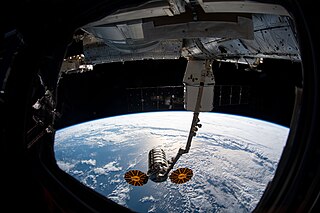
NG-11, previously known as OA-11, is the twelfth flight of the Northrop Grumman robotic resupply spacecraft Cygnus and its eleventh flight to the International Space Station under the Commercial Resupply Services (CRS-1) contract with NASA. The mission launched on 17 April 2019 at 20:46:07 UTC. This is the last mission from the extended CRS-1 contract; follow-up missions are part of the CRS-2 contract. Cygnus NG-11 was also the first mission to load critical hardware onto Cygnus within the last 24 hours prior to launch, a new Antares feature.

OmegA was a medium-lift to heavy-lift launch vehicle concept that spent several years in development by Northrop Grumman during 2016–2020, with that development substantially funded by the U.S. government. OmegA was intended for launching U.S. national security satellites, as part of the U.S. Department of the Air Force National Security Space Launch (NSSL) replacement program.
The GEOStar is a family of satellite buses designed and manufactured by Northrop Grumman Innovation Systems. The family started focused on small geostationary communications satellites. The first iterations focused on the sub-5 kW commercial segment that was left vacated after the retirement of the HS-376 satellite bus. It started with the STARBus on CTA Space Systems, which was later bought successively by Orbital Sciences, Orbital ATK, and most recently Northrop Grumman Innovation Systems.
The GEOStar-1 is a communications satellite spacecraft model made by Northrop Grumman Innovation Systems in the late 1990s for telecommunications in geosynchronous orbit. The GEOStar-1 satellite bus is designed for a 15-year mission and was compatible with the Ariane 4, Ariane 5, Delta II, Proton, and Long March.
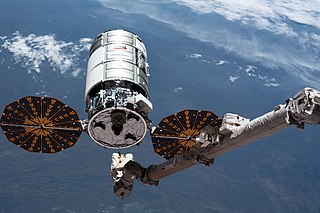
NG-12, previously known as OA-12, was the thirteenth flight of the Northrop Grumman robotic resupply spacecraft Cygnus and its twelfth Commercial Resupply Services flight to the International Space Station (ISS) for NASA. The mission launched on 2 November 2019 at 13:59:47 UTC). This was the first launch of Cygnus under the Commercial Resupply Services 2 (CRS-2) contract.

NG-13, previously known as OA-13, was the fourteenth flight of the Northrop Grumman robotic resupply spacecraft Cygnus and its thirteenth flight to the International Space Station (ISS) under the Commercial Resupply Services (CRS-1) contract with NASA. The mission launched on 15 February 2020 at 20:21:01 UTC after nearly a week of delays. This is the second launch of Cygnus under the CRS-2 contract.
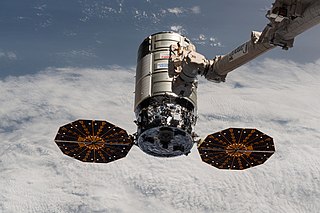
NG-14, previously known as OA-14, was the fifteenth flight of the Northrop Grumman robotic resupply spacecraft Cygnus and its fourteenth flight to the International Space Station under the Commercial Resupply Services (CRS-1) contract with NASA. The mission was launched on 3 October 2020, at 01:16:14 UTC.

NG-15, previously known as OA-15, was the fifteenth launch of the Northrop Grumman robotic resupply spacecraft Cygnus and its fourteenth flight to the International Space Station (ISS) under the Commercial Resupply Services (CRS) contract with NASA. The mission launched on 20 February 2021 at 17:36:50 UTC. This is the fourth launch of Cygnus under the CRS-2 contract.
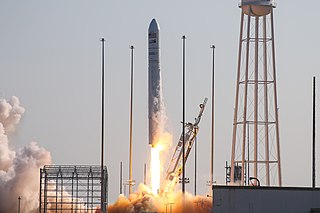
Cygnus NG-16, previously known as Cygnus OA-16, was the sixteenth flight of the Northrop Grumman robotic resupply spacecraft Cygnus and its fifteenth flight to the International Space Station (ISS) under the Commercial Resupply Services (CRS-2) contract with NASA. The mission was launched on 10 August 2021 at 22:01:05 UTC, for a (planned) 90-day mission at the ISS. This was the fifth launch of Cygnus under the CRS-2 contract.
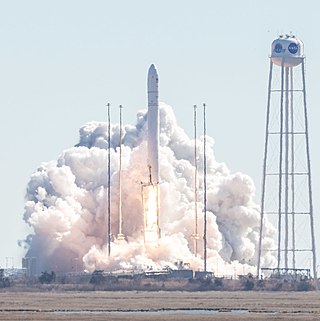
Cygnus NG-17, previously known as Cygnus OA-17, was the seventeenth flight of the Northrop Grumman robotic resupply spacecraft Cygnus and its sixteenth flight to the International Space Station (ISS) under the Commercial Resupply Services (CRS) contract with NASA. The mission launched on 19 February 2022 at 17:40:03 UTC. It was the sixth launch of Cygnus under the CRS-2 contract.

NG-18 was the eighteenth flight of the Northrop Grumman robotic resupply spacecraft Cygnus and its seventeenth flight to the International Space Station (ISS) under the Commercial Resupply Services (CRS-2) contract with NASA. The mission successfully launched on 7 November 2022 at 10:32:42 UTC. This was the seventh launch of Cygnus under the CRS-2 contract.
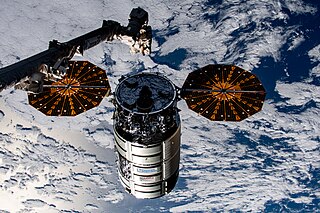
NG-19 is the nineteenth flight of the Northrop Grumman robotic resupply spacecraft Cygnus and its eighteenth flight to the International Space Station (ISS) under the Commercial Resupply Services (CRS-2) contract with NASA. The mission launched on 2 August 2023 at 00:31:14 UTC. This is the eighth launch of Cygnus under the CRS-2 contract.













